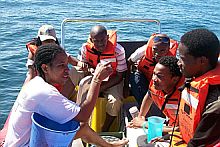Introducing students to marine and coastal sciences
Dumile Tshingana, Education Outreach Officer, SAEON Elwandle Node
|
The SAEON Elwandle Node and the South African Agency for Science and Technology Advancement (SAASTA) celebrated Marine Biosciences Month in an exciting and meaningful way.
The SAEON team presented exciting coastal research projects currently underway in the Eastern Cape at Walter Sisulu University (WSU) over a three-month period. Students who had demonstrated potential in biological sciences were selected to participate in the Bioscience Weekend Camp which took place in Grahamstown and Port Elizabeth. The participants were all students registered in WSU’s Biological Sciences Department.
Camp activities ranged from presentations by a well-qualified team of science presenters and science facilitators to scientific activities at sea. The event celebrated South Africa’s involvement in marine and coastal sciences and was specifically designed to provide a challenging and stimulating experience to encourage students to consider careers in these sciences.
The celebrations marked the fifth year of this SAASTA project’s five-year cycle, with SAEON leading the implementation of the initiative in the Eastern Cape. Institutions of higher learning, such as Walter Sisulu University that regularly participated in the event, gave a clear indication that the project had achieved its objectives.
The students from Walter Sisulu University unanimously expressed their appreciation for having been given this opportunity to learn more about the fascinating world of marine and coastal sciences and engaging in hands-on research activities.
The success of the initiative illustrated once again how important it is for research institutions and higher education institutions to work together to develop and implement broader frameworks that will expose our students to marine and coastal sciences.
From SAEON's perspective
The SAEON Elwandle Node’s postgraduate students Ntuthuko Masikane and Luzuko Dali reflect on the experience:
Following a generalised introduction to benthic ecology during the Marine Biosciences Month at Walter Sisulu University, the recent Bioscience Weekend provided an opportunity to expose the students to the practical science of benthicecology (e.g. sampling methodology), explains Ntuthuko Masikane. The marine environmental excursion kicked off with a tour inside the harbour (where a single sediment sample was taken) and later outside the harbour (where another sediment sample was taken). This provided the opportunity of placing benthic ecology into perspective (e.g. its role in informing environmental management, amongst others). Prior to the collection of benthic samples a benthic sampling protocol was explained in detail. Using Van Veen grab (sampling area: 211 cm2), two sediment samples (one inside the harbour and one outside the harbour; providing an opportunity to compare different communities) were collected and sieved through 500 µm mesh bag. Retained zoological organisms were sedated with MgCl2 and then fixed with formaldehyde. Fortunately both sediment samples included organisms big enough to identify different taxonomic groups (i.e. mysids in one sample and cumaceans in another sample).
The excursion was a practical follow-up to the presentations that were made at Walter Sisulu University where I presented the preliminary results of my project entitled Spatial Dynamics of Mesozooplankton in Algoa Bay. We took the students to the nearshore in Algoa Bay, where I’m doing my research, and firstly introduced them to the type of sampling materials that we are using. Furthermore we explained the strategy we are following and the aim of our research based on the available literature. The enthusiasm and response of the students was overwhelming. The excursion was undoubtedly a success because we all gained something from the exercise - Luzuko Dali. This project was made possible through funding from the Department of Science and Technology through SAASTA.













